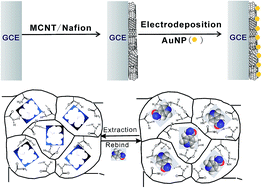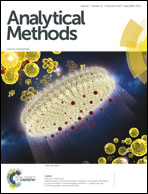A molecularly imprinted electrochemical sensor based on a gold nanoparticle/carbon nanotube hybrid material for the sensitive detection of isoniazid
Abstract
The molecular imprinted technique (MIT) is an approach to synthesize a polymer matrix with molecular recognition sites, which shows specific binding behavior to target molecules. MIT has been successfully applied in sensing areas due to their mechanical and chemical stability, high affinity and outstanding substrate recognition ability, low cost and easy preparation. Based on a gold nanoparticle/carbon nanotube hybrid material (AuNP–CNT) and molecularly imprinted polymer (MIP), we propose a novel molecularly imprinted electrochemical sensor to determine isoniazid (INH) selectively. The surfaces of glassy carbon electrodes (GCE) are modified by multi-walled carbon nanotubes (MCNT) decorated with gold nanoparticles (AuNP). The selectivity of INH detection is improved by the MIP membrane and the area of the electrochemical active surface area is increased by the AuNP–MCNT nanometer complex. INH is detected by stripping voltammetry and the effect of sound. The oxidation peak current and INH concentration have a linear relationship in the range of 1 × 10−9 to 1.4 × 10−8 M and 2 × 10−8 to 1.0 × 10−7 M, respectively. The detection limit is 0.3 × 10−9 M (3σ) INH with a relative standard deviation of 4.6% (n = 8) for 5 × 10−8 M INH after 60 s enrichment. The sensor can be applied to detect the INH in body fluid and pharmaceutical samples selectively. The solution of MIP–AuNP–MCNT/GCE exhibits remarkable advantages, such as low cost, ease to use, high selectivity and sensitivity.


 Please wait while we load your content...
Please wait while we load your content...